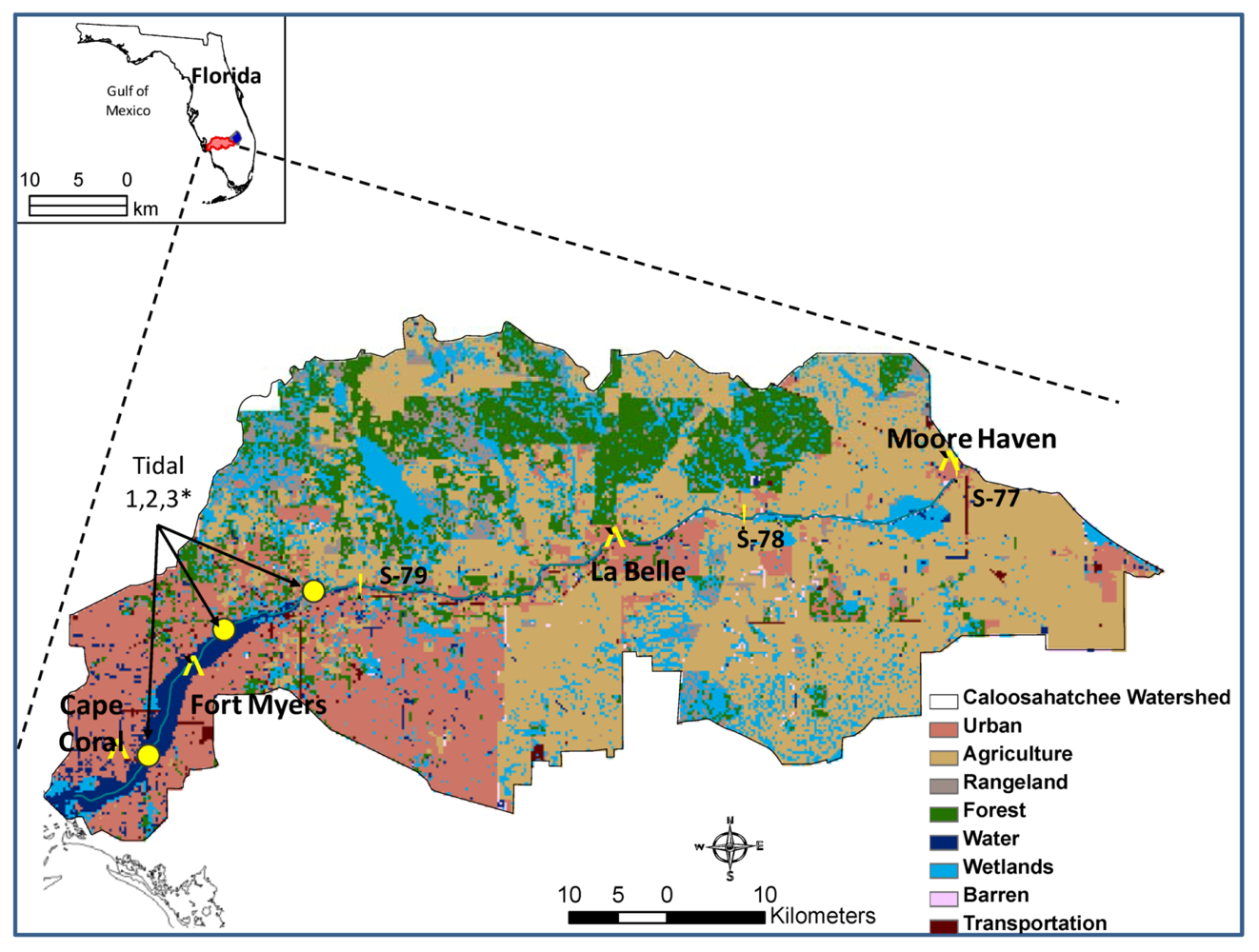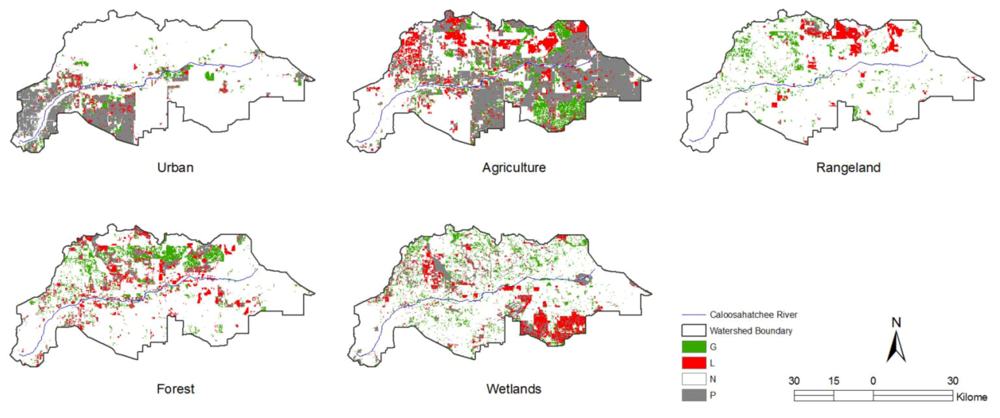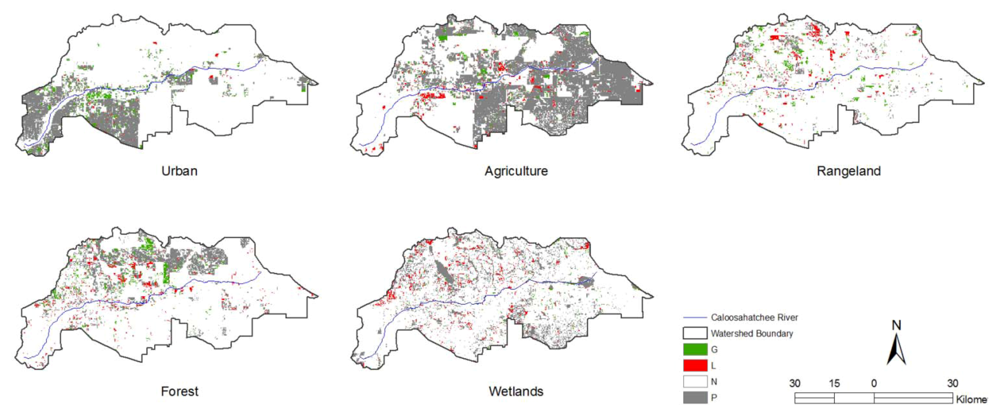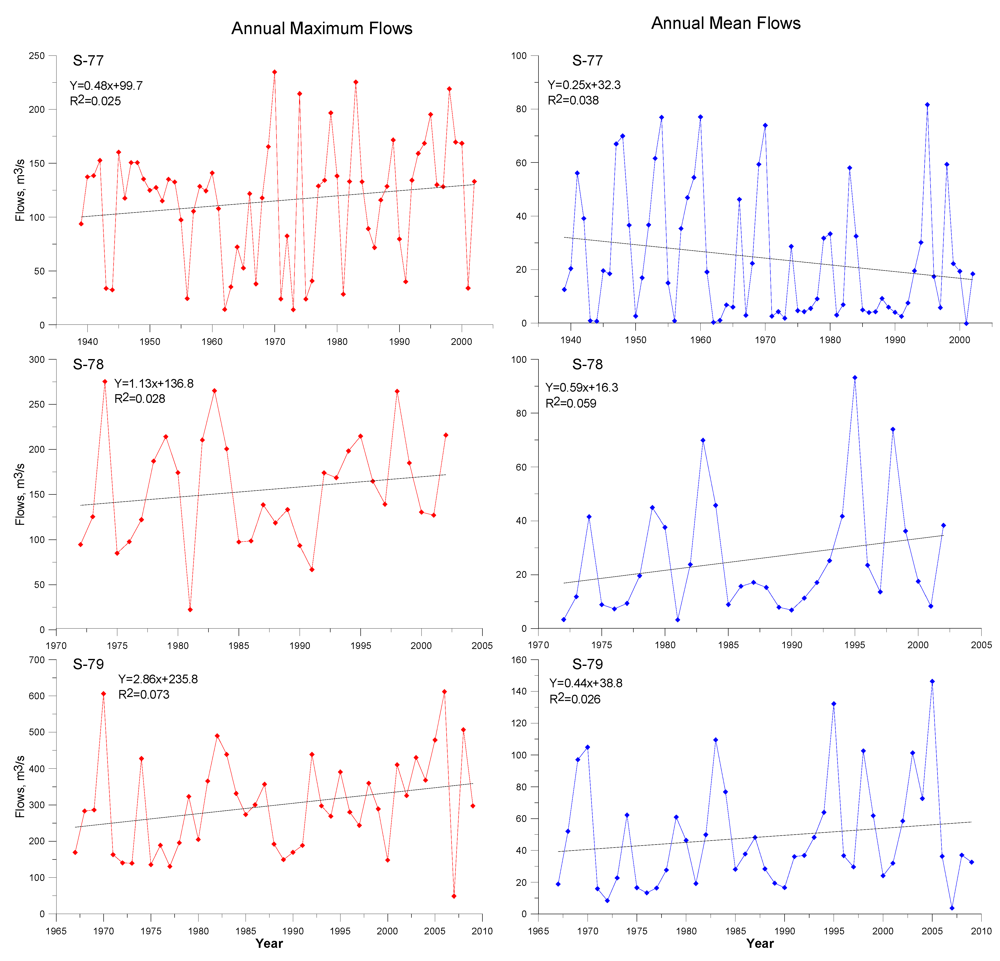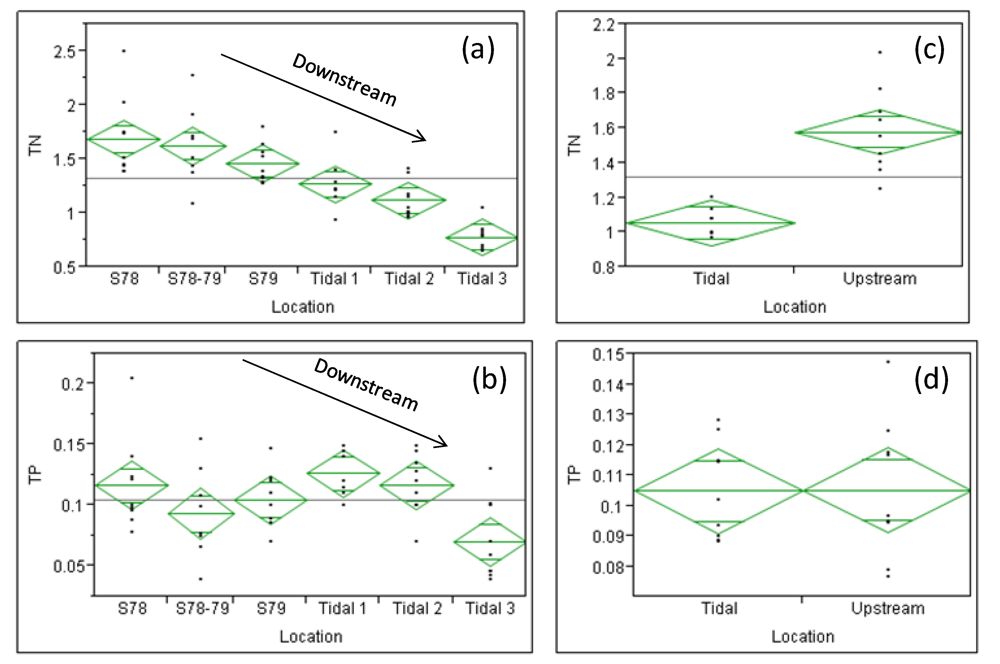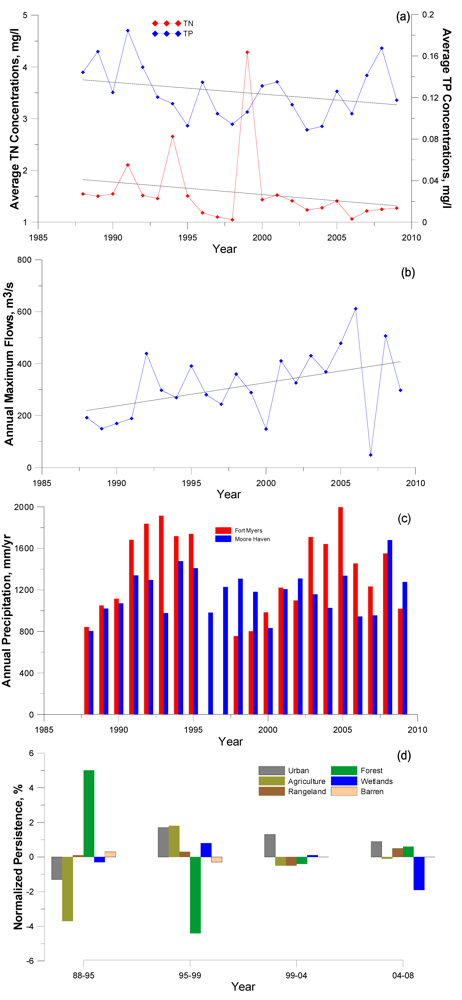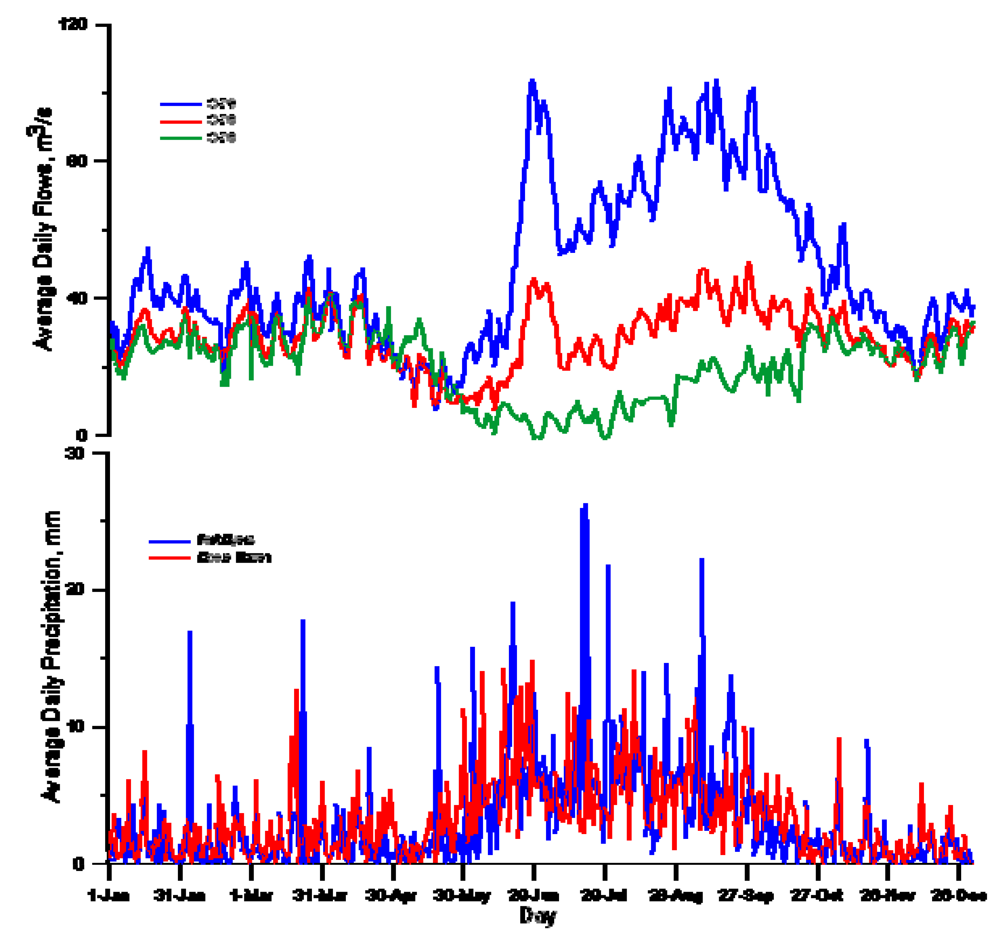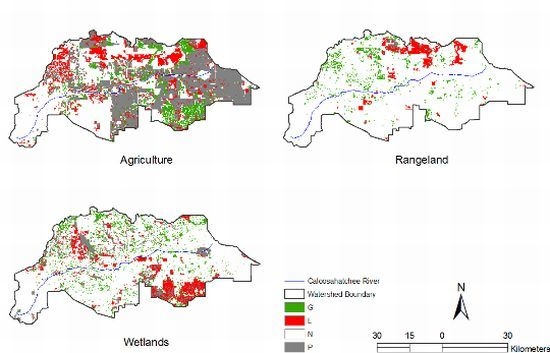3.1. Quantifying Land Use Changes
From
Figure 2, there were more wetlands in the southeastern portions of the watershed in 1988. However, these may have been converted to agriculture soon thereafter based on the maps from subsequent years. This is not unusual, as there has been extensive drainage of wetlands in the area to make room for agriculture and other land uses [
34]. Forests were more prevalent in 1995 than in the other years, based on
Table 2, and particularly in the northern part of the watershed (
Figure 2). Urban areas occurred primarily in the tidal portion of the watershed (downstream of S-79,
Figure 1); these areas have experienced some increases throughout the study period, based on
Table 2. Transportation was not mapped as extensively in other years as it was in 1995, based on further assessment of the spatial data; in particular, transportation was only mapped for the tidal portion in the 1988 land use, and while more extensive in the other years, the mapping was not as extensive for the tidal portion. For these reasons, changes involving transportation land use were excluded from further analyses. Overall, agriculture has been the dominant land use across the years, occupying >40% of the watershed area, with urban, wetlands and forest land uses being the next largest, and ranging between 16–21%, 15–17% and 13–18% of the watershed area, respectively.
Figure 2.
Land-use in the Caloosahatchee River watershed during various periods, as determined from analyses of existing data.
Figure 2.
Land-use in the Caloosahatchee River watershed during various periods, as determined from analyses of existing data.
Table 2.
Land-use distribution (% of analyzed area, 1988–2008) in the study watershed.
Table 2.
Land-use distribution (% of analyzed area, 1988–2008) in the study watershed.
| Land Use | 1988 | 1995 | 1999 | 2004 | 2008 |
|---|
| Agriculture | 46.3 | 42.0 | 44.2 | 43.5 | 43.3 |
| Urban | 17.8 | 16.3 | 18.1 | 19.4 | 20.3 |
| Wetlands | 16.0 | 15.7 | 16.4 | 16.7 | 14.9 |
| Forest | 13.3 | 18.1 | 14.0 | 13.5 | 14.1 |
| Rangeland | 5.5 | 5.5 | 6.0 | 5.5 | 5.9 |
| Barren | 0.7 | 1.0 | 0.6 | 0.6 | 0.5 |
| Transportation* | 0.4 | 1.4 | 0.7 | 0.7 | 0.9 |
Table 3 shows gains, losses, net changes and persistence of land uses in the Caloosahatchee River Watershed based on analyses of existing data.
Figure 3 and
Figure 4 show gains (G), losses (L) and persistence (P) of the major land uses in the watershed between 1988 and 1999 (
Figure 3) and between 1999 and 2008 (
Figure 4). From
Table 3, agriculture experienced the highest gains during the period 1988–2008 (10%), with these gains mostly occurring between 1988 and 1999. Similarly, agriculture experienced the largest losses (12.7%), with the largest being in the 1988–1999 period. Despite these changes, the overall net change for agriculture during 1988-2008 was relatively low (2.7%), indicating that the gains balanced the losses. Interestingly, urban areas experienced a corresponding gain (2.7%) during the same time period, based on
Table 3.
Table 3.
Gains, losses, net changes and persistence of land uses in the Caloosahatchee River Watershed, based on existing data.
Table 3.
Gains, losses, net changes and persistence of land uses in the Caloosahatchee River Watershed, based on existing data.
| Period |
|---|
| 88–95 | 95–99 | 99–04 | 04–08 | 88–99 | 99–08 | 88–08 |
|---|
| Gains | | | | | | | |
| Urban | 2.8 | 3.2 | 1.6 | 1.3 | 3.2 | 2.6 | 4.8 |
| Agriculture | 8.1 | 5.9 | 1.1 | 1.0 | 10.1 | 1.7 | 10.0 |
| Rangeland | 4.6 | 3.8 | 0.9 | 1.8 | 5.3 | 2.2 | 5.5 |
| Forest | 11.1 | 3.6 | 0.9 | 2.0 | 8.3 | 2.5 | 8.5 |
| Wetlands | 8.1 | 4.7 | 0.8 | 0.5 | 8.5 | 0.9 | 7.3 |
| Barren | 0.7 | 0.3 | 0.2 | 0.1 | 0.4 | 0.2 | 0.4 |
| Losses | | | | | | | |
| Urban | 4.1 | 1.5 | 0.2 | 0.3 | 2.7 | 0.4 | 2.1 |
| Agriculture | 11.9 | 4.1 | 1.6 | 1.1 | 12.2 | 2.3 | 12.7 |
| Rangeland | 4.5 | 3.5 | 1.4 | 1.4 | 4.8 | 2.3 | 5.1 |
| Forest | 6.1 | 8.0 | 1.3 | 1.4 | 7.6 | 2.3 | 7.6 |
| Wetlands | 8.5 | 3.8 | 0.6 | 2.4 | 8.1 | 2.7 | 8.5 |
| Barren | 0.4 | 0.6 | 0.2 | 0.1 | 0.4 | 0.2 | 0.5 |
| Net Change | | | | | | | |
| Urban | −1.3 | 1.7 | 1.3 | 0.9 | 0.5 | 2.3 | 2.7 |
| Agriculture | −
3.7 | 1.8 | −0.5 | −0.1 | −2.1 | −0.6 | −
2.7 |
| Rangeland | 0.1 | 0.3 | −0.5 | 0.5 | 0.5 | −0.1 | 0.4 |
| Forest | 5.0 | −
4.4 | −0.4 | 0.6 | 0.7 | 0.2 | 0.9 |
| Wetlands | −0.3 | 0.8 | 0.1 | −1.9 | 0.4 | −1.8 | −1.2 |
| Barren | 0.3 | −0.3 | 0.0 | 0.0 | 0.0 | 0.0 | −0.1 |
| Normalized Persistence | | | | | | | |
| Urban | 0.77 | 0.91 | 0.99 | 0.98 | 0.85 | 0.98 | 0.88 |
| Agriculture | 0.75 | 0.90 | 0.96 | 0.98 | 0.74 | 0.95 | 0.73 |
| Rangeland | 0.19 | 0.38 | 0.77 | 0.75 | 0.13 | 0.62 | 0.07 |
| Forest | 0.55 | 0.57 | 0.91 | 0.90 | 0.44 | 0.84 | 0.43 |
| Wetlands | 0.48 | 0.75 | 0.96 | 0.86 | 0.50 | 0.84 | 0.48 |
| Barren | 0.42 | 0.32 | 0.74 | 0.76 | 0.30 | 0.64 | 0.20 |
However, a look at
Figure 3 and
Figure 4 shows that these changes did not correspond with regard to spatial extent, rather that gains in agricultural lands came from primarily wetland areas, while urban and agriculture also experienced gains from other land uses in the watershed. Forests experienced gains of 5% in 1988–1995 and an almost corresponding loss (4.4%) in the subsequent time period. Overall, forests did not experience large changes beyond 1999 and maintained high levels of persistence (≈0.9 or 90% in 1999–2004 and 2004–2008). Barren land showed the lowest net change, as gains experienced in this land use almost always balanced the losses. Urban and agricultural lands experienced the highest level of persistence during the study period, with this being primarily in the period between 1999–2008 (0.95 and 0.98, respectively), suggesting that these land uses remained fairly stable relative to other land uses in the watershed during this period. Rangeland and barren land were the most dynamic land uses, with only 0.07 and 0.20 persistence, respectively. However, these land uses also occupied very small portions of the watershed area (≤6% and ≤1%).
Figure 3.
Gains (G), losses (L) and persistence (P) of land uses in the Caloosahatchee River Watershed between 1988 and 1999 based on existing data. Areas not in the land use concerned are represented as “N”.
Figure 3.
Gains (G), losses (L) and persistence (P) of land uses in the Caloosahatchee River Watershed between 1988 and 1999 based on existing data. Areas not in the land use concerned are represented as “N”.
Figure 4.
Gains (G), losses (L) and persistence (P) of land uses in the Caloosahatchee River Watershed between 1999 and 2008, based on existing data. Areas not in the land use concerned are represented as “N”.
Figure 4.
Gains (G), losses (L) and persistence (P) of land uses in the Caloosahatchee River Watershed between 1999 and 2008, based on existing data. Areas not in the land use concerned are represented as “N”.
Based on
Figure 3, urban and agricultural lands both gained from wetlands, while forest land use gained from both rangeland and agricultural lands. This is consistent with information in Flaig and Capece [
34], which shows increases in agriculture and decreases in wetlands and rangeland in the western portion of the watershed (between S79 and S78). However, this picture is not mirrored in east Caloosahatchee for which Flaig and Capece [
34] showed increases in agriculture with corresponding decreases in range land and only very slight decreases in wetlands. Both agriculture and urban lands showed relatively higher levels of persistence during the period of 1988–1999 compared to the other land uses, consistent with the data shown in
Table 3. In the period between 1999 and 2008, all land uses showed higher tendencies towards persistence in comparison to the preceding period, and in general. Wetlands, however, appeared to be more dynamic than the other land uses during this period. Urban areas were mainly located in the tidal portions of the watershed, while agriculture mostly occupied the upland portion of the watershed based on the two figures. This is also the current status of the watershed (
Figure 1).
Table 4.
Inter-category changes in the Caloosahatchee River Watershed in 1988–1999: Focus on gains.
Table 4.
Inter-category changes in the Caloosahatchee River Watershed in 1988–1999: Focus on gains.
| 1999 | 1 | 2 | 3 | 4 | 5 | 6 | | |
|---|
| | Urban | Agric | Range | Forest | Wetlands | Barren | Totals Time 1 | Loss |
|---|
| 1988 | | | | | | | | | |
| 1 | Urban | 14.86 | 0.82 | 0.29 | 0.75 | 0.80 | 0.05 | 17.57 | 2.7 |
| PRij | 14.86 | 3.34 | 0.99 | 1.69 | 1.78 | 0.07 | 22.7 | 7.9 |
| Dij | 0.00 | −2.52 | −0.70 | −0.94 | −0.97 | −0.01 | −5.2 | −5.2 |
| Bij | 0.00 | −0.76 | −0.71 | −0.56 | −0.55 | −0.20 | −0.2 | −0.7 |
| 2 | Agric | 1.49 | 34.63 | 2.62 | 3.81 | 4.12 | 0.19 | 46.86 | 12.2 |
| | 1.81 | 34.63 | 2.65 | 4.50 | 4.74 | 0.18 | 48.5 | 13.9 |
| | −0.32 | 0.00 | −0.03 | −0.69 | −0.63 | 0.01 | −1.7 | −1.7 |
| | −0.18 | 0.00 | −0.01 | −0.15 | −0.13 | 0.07 | 0.0 | −0.1 |
| 3 | Range | 0.27 | 1.99 | 0.73 | 1.54 | 1.03 | 0.00 | 5.56 | 4.8 |
| | 0.21 | 1.06 | 0.73 | 0.53 | 0.56 | 0.02 | 3.1 | 2.4 |
| | 0.05 | 0.93 | 0.00 | 1.01 | 0.46 | −0.02 | 2.4 | 2.4 |
| | 0.25 | 0.88 | 0.00 | 1.89 | 0.83 | −0.83 | 0.8 | 1.0 |
| 4 | Forest | 0.90 | 2.78 | 1.37 | 5.83 | 2.47 | 0.05 | 13.40 | 7.6 |
| | 0.52 | 2.55 | 0.76 | 5.83 | 1.36 | 0.05 | 11.1 | 5.2 |
| | 0.38 | 0.23 | 0.61 | 0.00 | 1.11 | 0.00 | 2.3 | 2.3 |
| | 0.73 | 0.09 | 0.81 | 0.00 | 0.82 | 0.01 | 0.2 | 0.4 |
| 5 | Wetlands | 0.41 | 4.38 | 1.02 | 2.18 | 7.95 | 0.08 | 16.02 | 8.1 |
| | 0.62 | 3.05 | 0.90 | 1.54 | 7.95 | 0.06 | 14.1 | 6.2 |
| | −0.21 | 1.34 | 0.12 | 0.64 | 0.00 | 0.02 | 1.9 | 1.9 |
| | −0.34 | 0.44 | 0.13 | 0.42 | 0.00 | 0.30 | 0.1 | 0.3 |
| 6 | Barren | 0.12 | 0.13 | 0.03 | 0.04 | 0.08 | 0.18 | 0.59 | 0.4 |
| | 0.02 | 0.11 | 0.03 | 0.06 | 0.06 | 0.18 | 0.5 | 0.3 |
| | 0.10 | 0.02 | 0.00 | −0.02 | 0.02 | 0.00 | 0.1 | 0.1 |
| | 4.30 | 0.19 | −0.09 | −0.27 | 0.42 | 0.00 | 0.3 | 0.4 |
| Totals Time 2 | 18.04 | 44.74 | 6.06 | 14.15 | 16.45 | 0.56 | 100.0 | |
| Gain | | 3.18 | 10.11 | 5.33 | 8.31 | 8.50 | 0.39 | | |
Table 5.
Intercategory changes in the Caloosahatchee River Watershed in 1988–1999: Focus on losses.
Table 5.
Intercategory changes in the Caloosahatchee River Watershed in 1988–1999: Focus on losses.
| 1999 | 1 | 2 | 3 | 4 | 5 | 6 | Totals Time 1 | |
|---|
| | Urban | Agric | Range | Forest | Wetlands | Barren | Loss |
|---|
| 1988 | | | | | | | | | |
| 1 | Urban | 14.86 | 0.82 | 0.29 | 0.75 | 0.80 | 0.05 | 17.57 | 2.72 |
| PRij | 14.86 | 1.48 | 0.20 | 0.47 | 0.55 | 0.02 | 17.57 | |
| Dij | 0.00 | −0.67 | 0.09 | 0.28 | 0.26 | 0.04 | 0.00 | |
| Bij | 0.00 | −0.45 | 0.46 | 0.60 | 0.48 | 1.91 | 0.00 | |
| 2 | Agric | 1.49 | 34.63 | 2.62 | 3.81 | 4.12 | 0.19 | 46.86 | 12.2 |
| | 3.99 | 34.63 | 1.34 | 3.13 | 3.64 | 0.12 | 46.86 | |
| | −2.50 | 0.00 | 1.28 | 0.68 | 0.48 | 0.07 | 0.00 | |
| | −0.63 | 0.00 | 0.95 | 0.22 | 0.13 | 0.56 | 0.00 | |
| 3 | Range | 0.27 | 1.99 | 0.73 | 1.54 | 1.03 | 0.00 | 5.56 | 4.8 |
| | 0.93 | 2.30 | 0.73 | 0.73 | 0.85 | 0.03 | 5.56 | |
| | −0.66 | −0.31 | 0.00 | 0.81 | 0.18 | −0.03 | 0.00 | |
| | −0.71 | −0.13 | 0.00 | 1.12 | 0.21 | −0.87 | 0.00 | |
| 4 | Forest | 0.90 | 2.78 | 1.37 | 5.83 | 2.47 | 0.05 | 13.40 | 7.6 |
| | 1.59 | 3.94 | 0.53 | 5.83 | 1.45 | 0.05 | 13.40 | |
| | −0.69 | −1.16 | 0.83 | 0.00 | 1.02 | 0.00 | 0.00 | |
| | −0.44 | −0.29 | 1.56 | 0.00 | 0.70 | 0.06 | 0.00 | |
| 5 | Wetlands | 0.41 | 4.38 | 1.02 | 2.18 | 7.95 | 0.08 | 16.02 | 8.1 |
| | 1.74 | 4.32 | 0.59 | 1.37 | 7.95 | 0.05 | 16.02 | |
| | −1.34 | 0.06 | 0.44 | 0.81 | 0.00 | 0.03 | 0.00 | |
| | −0.77 | 0.01 | 0.75 | 0.59 | 0.00 | 0.48 | 0.00 | |
| 6 | Barren | 0.12 | 0.13 | 0.03 | 0.04 | 0.08 | 0.18 | 0.59 | 0.4 |
| | 0.07 | 0.18 | 0.02 | 0.06 | 0.07 | 0.18 | 0.59 | |
| | 0.05 | −0.05 | 0.01 | −0.02 | 0.02 | 0.00 | 0.00 | |
| | 0.62 | −0.28 | 0.20 | −0.29 | 0.25 | 0.00 | 0.00 | |
| Totals Time 2 | 18.04 | 44.74 | 6.06 | 14.15 | 16.45 | 0.56 | 100.0 | |
| | 23.18 | 46.86 | 3.42 | 11.59 | 14.50 | 0.45 | | |
| | −5.14 | −2.13 | 2.65 | 2.56 | 1.95 | 0.11 | | |
| | −0.22 | −0.05 | 0.77 | 0.22 | 0.13 | 0.24 | | |
Table 4 and
Table 5 show inter-category changes in the Caloosahatchee River watershed with a focus on gains (
Table 4) and losses (
Table 5). Based on these tables, forests and wetlands had the tendency to gain from rangeland (
Bij = 1.89, 0.83, respectively;
Table 4), while rangeland showed a corresponding tendency to lose to forests and wetlands (
Bij = 1.12, 0.21, respectively;
Table 5). Rangeland and wetlands showed a tendency to gain from forests (
Bij = 0.81, 0.82, respectively), while forest showed a corresponding tendency to lose to the two land uses (
Bij = 1.56, 0.70, respectively). Agriculture, rangeland, forest and barren lands showed the tendency to gain from wetlands (
Bij = 0.44, 0.13, 0.42 and 0.30, respectively), while wetlands showed a corresponding tendency to lose to these land uses (
Bij = 0.01, 0.75, 0.59 and 0.48, respectively), even though the signal for agriculture was very weak.
Both urban and wetlands showed the tendency to gain from barren lands (
Bij = 4.30, 0.42, respectively), and the corresponding tendency for barren lands to lose to urban and wetlands was seen in
Table 5 (
Bij = 0.52, 0.25, respectively). While both urban and agriculture showed a tendency to gain from rangelands based on
Table 4 (
Bij = 0.25, 0.88), a corresponding tendency for rangelands to lose to these land uses was not seen in
Table 5. Similarly, results from the gains- and loss-based analyses did not correspond with respect to forests and urban lands. Thus, the associated results were disregarded to avoid misinterpretation, consistent with information in [
16].
Similarly, for the period 1999–2008, barren lands showed the tendency to gain from agriculture (Bij = 0.22), while agriculture showed a corresponding tendency to lose to barren lands (Bij = 3.36). While all land uses showed the tendency to gain from rangelands (Bij ranging from 1.12 for urban to 4.62 for forest), rangeland only showed a corresponding tendency to lose to forests and barren land (Bij = 1.82, 1.50, respectively) based on the loss matrix. Urban, rangeland and wetlands showed the tendency to gain from forest (Bij = 0.50, 1.70, 1.32, respectively), while forest only showed a tendency to lose to urban and rangelands ((Bij = 0.24, 4.67, respectively). Rangelands and forests had the tendency to gain from wetlands (Bij = 0.65, 1.27, respectively), while wetlands showed the tendency to lose to both land uses (Bij = 2.45, 1.41, respectively). Corresponding tendencies were also found between urban and rangelands and barren lands (Bij = 3.14, 3.70, respectively, for gains; Bij = 0.80, 4.18, respectively, for losses).
In general, barren lands tended to convert to urban, rangeland and, to some extent, wetlands, based on matrices for 1988–2008. Additionally, rangelands tended to convert to forests and wetlands, forests to rangeland and wetlands and wetlands to rangeland and forest, based on the analyses. As with the periods of 1988–1999 and 1999–2008, there were tendencies for gains that were not mirrored in the loss matrix and vice versa. These were left out to avoid misinterpretation.
3.4. Water Quality Trends
From
Figure 8(a), total nitrogen (TN) concentrations decreased coming from the upland to the tidal portion of the watershed, with nitrogen concentrations being above the global mean for the watershed (solid horizontal line) in the upland portion and below the mean in the tidal portion of the watershed. Comparison test showed that TN concentrations were significantly different among the various locations (p
0.05 = 0.0001). In contrast, phosphorus concentrations (
Figure 8(b)) were scattered among the locations, with no clear trend being observed. In the upland portion of the watershed, total phosphorus (TP) concentrations were higher above S-78, this possibly being reflective of discharges from Lake Okeechobee, and dropped between S78-79. However, concentrations increased again at S-79, possibly reflecting contributions from agricultural lands. Mean concentrations in the tidal portions of the watershed (Tidal 1 and Tidal 2) were higher than those at S-79 and between S-78 and S-79, but were close to the mean concentration at S-78. This increase in TP concentrations in the tidal portions of the watershed is possibly indicative of contributions from the urban lands surrounding that area. Concentrations at Tidal 3 were much lower than those from all the other sections of the watershed, possibly due to a dilution effect and/or from influx of sea water and storm surges. TP concentrations at Tidal 1 and Tidal 2 were comparable to those at S-78, which are reflective of inflows from Lake Okeechobee.
Figure 8.
(a) Total N concentrations (mg/L) along the Caloosahatchee River. (b) Total P concentrations (mg/L) along the Caloosahatchee River. (c) Comparisons between upstream and tidal reaches for Total N. (d) Comparisons between upstream and tidal reaches for Total P.
Figure 8.
(a) Total N concentrations (mg/L) along the Caloosahatchee River. (b) Total P concentrations (mg/L) along the Caloosahatchee River. (c) Comparisons between upstream and tidal reaches for Total N. (d) Comparisons between upstream and tidal reaches for Total P.
Comparison test for TP also showed significant differences among the various locations (p
0.05 = 0.0133). Comparing the averages for the upland and tidal portions of the watershed (
Figure 8(c)) for TN, concentrations in the upland areas of the watershed were significantly higher (p
0.05 = 0.0003) than those in the tidal portions of the watershed. For TP (
Figure 8(d)), there were no significant differences between average upland and tidal concentrations (p
0.05 = 0.8946). These findings were confirmed through an analysis of more detailed data at S-79 and at Tidal 1, in which TN differences were found to be significant (p
0.05 = 0.0002), while those for TP were not significant (p
0.05 = 0.0617). An analysis of more detailed data showed a significant downward trend with time in TN (Kendall’s Tau = −4074; p
0.05 = 0.0023) at S-79. TN at Tidal 1 also exhibited a significant downward trend (Kendall’s Tau = −0.2934; p
0.05 = 0.0318) over the years, although not as strongly as at S-79. At S-79, TP also exhibited a significant downward trend over time (Kendall’s Tau = −0.3757; p
0.05 = 0.0050) based on analyses of detailed data. TP trends were, however, not significant at Tidal 1.
Figure 9.
(a) mean daily total nitrogen (TN) and total phosphorus (TP) concentrations. (b) daily maximum flows. (c) annual precipitation at Fort Myers and Moore Haven. (d) net changes in land use (%). Flow and nutrient values are from/for S-79.
Figure 9.
(a) mean daily total nitrogen (TN) and total phosphorus (TP) concentrations. (b) daily maximum flows. (c) annual precipitation at Fort Myers and Moore Haven. (d) net changes in land use (%). Flow and nutrient values are from/for S-79.
Based on
Figure 9(a,b), there was a general decrease in TN and TP concentrations between 1988 and 2009 and a steady increase in maximum daily flows at S-79, consistent with previous results. The general decrease in concentrations might be attributable to a dilution effect resulting from the general increase in flows, or might be reflective of a change in management in the watershed. A look at climate data
Figure 9(c) showed that precipitation followed a normal cyclic pattern with periods of highs and lows, typical of precipitation in many areas. As seen previously, the major changes in land use occurred in the period between 1988 and 1999, with forests experiencing the largest gain in 1988–1995 and a subsequent loss in 1995–1999. Agriculture and urban areas experienced a corresponding loss in 1988–1995 and subsequent gains in 1995–1999. Wetlands experienced an appreciable decrease in 2004–2008, a loss which was spread out among the other land uses.
3.5. General Discussion
Based on the analysis of land use data, agriculture and urban land uses experienced the highest levels of persistence, with the land uses experiencing a net decrease and a net increase of 2.7%, respectively. More detailed assessments, however, showed that gains in urban areas did not occur in the same spatial locations as did losses in agricultural lands, and thus, gains in urban areas were not a result of losses in agriculture. While the net changes observed in agricultural and urban lands are relatively low during the study period, current coverage is reflective of tremendous changes that have occurred historically, following channelization of the main channel and construction of flow regulating structures [
22]. These land uses combined occupied less than 2% of the watershed area in the late 1950s, with the watershed being primarily in forest and wetlands at that time [
34]. Additionally, results from analysis of census data suggest that a substantial change might have occurred in land cover within already existing urban land use areas during the study period. While forests and wetlands exhibited relatively high levels of persistence in 1999–2008 (84%), their overall persistence over the land use study period was low (43% and 48%, respectively). This lack of persistence was also reflected in the developed maps. Wetlands are difficult to map due to their highly dynamic nature [
35,
36], and their classification is often reflective of the existing management and/or hydrologic regime [
36]. Thus, while major changes in wetlands can be discerned from the analyses, transitions between wetlands, and (particularly) forests and rangelands, may be more reflective of the status at the time of classification, rather than of true land use changes.
Significant trends in time series data in the period of 1988–2008 were mainly observed at S-79. These included increases in maximum daily flows at S-79, as well as decreases in TN and TP concentrations. While trends were observed in some of the other time series that were analyzed, they were not significant. Based on existing literature, however, changes in daily flows do occur over the course of a year with great variations between seasons [
22,
34]. This is reflected in
Figure 10, which shows average daily flows at the three stations in the watershed during the period of 1988–2002 (2002 was used as the cutoff for comparison purposes, as two of the stations only had data through 2002). During the summer months (June–October), flow through S-79 often exceeded the recommended 70 m
3/s documented in [
34], which has implications on the ecological well-being of the Caloosahatchee estuary. While flows during November to May did not differ much among the stations, flows were much higher at S-79 than at the other two stations and were also higher at S-78 than at S-77. The latter reflects primarily discharges from Lake Okeechobee, while the former two reflect primarily contributions from the watershed, consistent with information in [
37]. There were no appreciable trends in precipitation, based on the analyses of long-term data. In addition, changes in hydrology and water quality were not necessarily reflective of changes in land use; rather, these changes were thought to be reflective of changes in the management of the stream channel to meet ecological needs. Further, since no appreciable changes occurred in agricultural land use during the land use study period, decreases in nutrient concentrations could also be attributable to changes in management within existing agricultural land use. The data did, however, show somewhat higher TP concentrations in the tidal portion of the watershed than in the mid (agricultural) section of the watershed, suggesting substantial contributions from urban areas. This is in line with census data, which showed a rapidly increasing urban population in an area that did not exhibit corresponding spatial expansion.
Figure 10.
Average daily flows and precipitation (secondary Y-axis) at the Caloosahatchee stations during the period of 1988–2002.
Figure 10.
Average daily flows and precipitation (secondary Y-axis) at the Caloosahatchee stations during the period of 1988–2002.
Overall, results provided useful information and insights into the extent, nature of and possible impacts of land use and related changes that have occurred in the watershed in the recent past, all of which can be used for watershed decision making. For example, results suggest that there have been localized changes within urban land uses and that these changes are potentially impacting estuarine water quality, thus pointing to the need for a more in-depth assessment of this land use and, similarly, for agriculture. In this regard, the information obtained can also be used to guide the development of conservation measures and/or land use development policies. Results also show that stream flow patterns along the main channel are not reflective of watershed dynamics, thus pointing to the need to monitor tributary channels more extensively in order to better characterize watershed responses for future watershed decision making. Further assessments using automated modeling techniques, such as those described in [
38,
39,
40], would allow more detailed evaluation and would be especially useful in detecting additional historical patterns that are otherwise not discernible. The accuracy of modeling techniques, however, varies with the net change experienced and with the resolution of the data [
40]. Thus, the results would also need to be interpreted in context, considering the historical perspective, and with a working knowledge of the watershed.
